
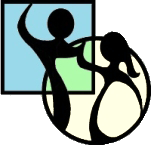
Square and Round Dance Federation
of Nova Scotia
Frequently asked Questions
| What is square dancing? | What is round dancing? | What is contra dancing? |
| What do I wear? | How much does it cost? | Time committment? |
| Learning difficulty? | Do I need a partner? | Health benefits? |
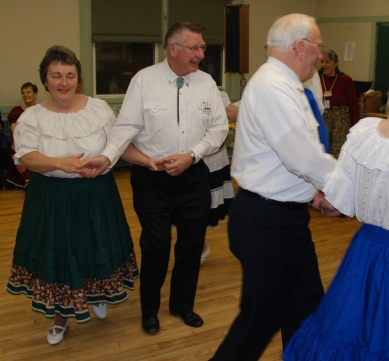
Square Dancing organizes the dancers into groups of eight who form a square of 4 couples at the start of the dance. Traditional Square Dancing featured named dances that were set patterns often known to all of the local dancers. In its modern form the square dance choreography uses a vocabulary of calls known to the dancers. The caller "calls" these moves to create an endless variety of figures to keep the dancers entertained. Some figures are old favourites and some are spontaneous new creations. The music for Square Dancing ranges across many genres requiring only that it can be played at about 128 beats per minute. Expect to hear classic sing-a-longs, ragtime, jazz, big band, rock 'n' roll, folk songs, music from musicals and movies, country and western, disco, Latin, and what ever else might please the dancers. BACK
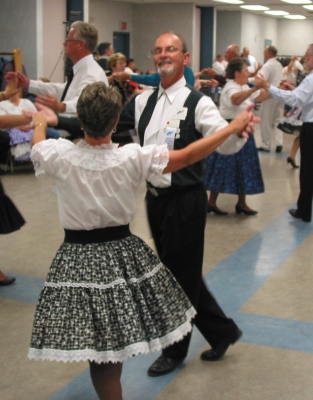
Round Dancing organizes the dancers in couples facing counterclockwise around a big circle. It is basically pre-choreographed and cued ballroom dancing. Many choreographers have written superb choreography for specific pieces of music. This choreography is graded according to the number and difficulty of the moves used. Dancers learn the individual moves in a rhythm and phase (difficulty level) and with just a bit of practice are able to learn any dance that uses the set of moves, or with more experience are able to dance straight from the cues. Rhythms include waltz, two-step, polka, foxtrot, jive, rumba, cha-cha, tango and others. BACK
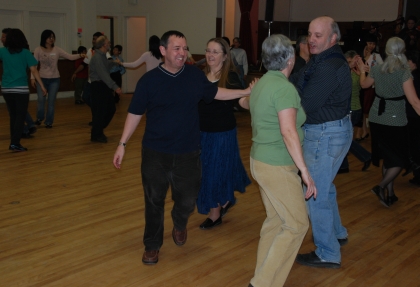
Contra Dancing usually organizes the dancers in facing lines. Dances are almost always walked through ahead of time. They typically consist of a 64-step figure that repeats, which helps less experienced participants smooth out their movements as the dance progresses. The music and choreography are more closely melded together than in Square Dancing, with clear emphasis on the 8-beat phrasing. Although modern music is sometimes used, many of the classic dances were choreographed for traditional jigs and reels. BACK
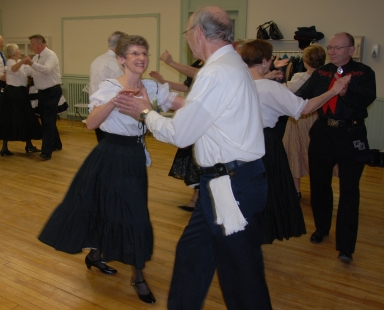
The most important item of clothing is a pair of comfortable, soft-soled shoes with good support. For square and round dancing ladies might prefer to wear a comfortable skirt to ensure freedom for moving. For many years the traditional attire has been a knee length full skirt over a crinoline with pettipants. Although ladies are sometimes initially reluctant to wear this attire, it is actually very appropriate for the activity and great fun to swish and twirl the skirts. Prairie skirts are also popular, however, and are accepted everywhere. Gentlemen often wear a long-sleeved shirt.
The traditional dress code has greatly relaxed over the years. Many events today are casual, accepting any clean and neat street-wear. All-in-all, there is little need for specialized dance clothing. BACK
The average cost is about $5 per person per dance event. Sometimes that is collected as yearly club dues, in other cases the philosophy is "pay as you go". Club members also pay a small yearly membership fee in the National Square and Round Dance Society, which includes third party liability insurance coverage. BACK
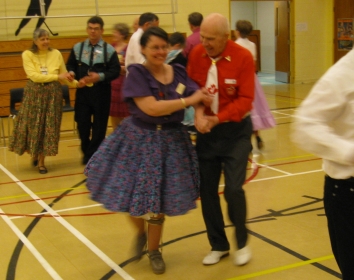
Clubs usually dance once a week from September to May with a break for the Christmas holidays. Several clubs in the Metro area offer beginner Square or Round Dancing, and those dances are also held weekly. A typical dance lasts two hours, and most are held in the evenings. The Metro Association sponsors a reduced schedule of dances during the summer; visitors are always welcome. Follow the links above to find more information about clubs in Metro and elsewhere in Nova Scotia. The local contact number for Metro is 902-435-4544.
Within a year of weekly dancing most dancers learn enough vocabulary to be able to dance at similar clubs across Canada and around the world. The same list of moves is used worldwide and called everywhere in English, allowing dancers to truly enter a world of fun and friendship. BACK
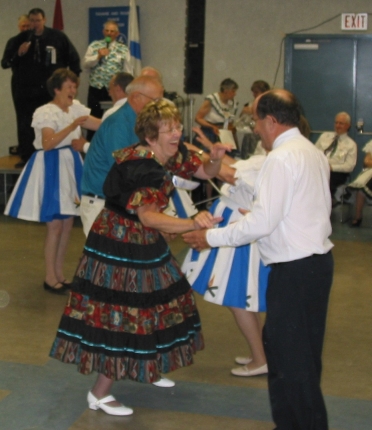
Learning how to square or round dance is something like learning how to play a sport. You need to learn "the moves" and you need to practice - that's what weekly beginner dances are all about. At those dances you'll meet friendly folks who've already been where you're going, and are glad to help. You'll find that they're generally not naturally gifted dancers. They make mistakes like anyone else, and have learned that it's just part of the dance activity. Like them, you'll soon learn to laugh and enjoy the moments of comedy created by our human imperfections. You'll also experience the sense of accomplishment after realizing that "hey, I can DO this!" BACK
Two people form the basic unit of square, round, and contra dancing. The Halifax-based contra dance club welcomes singles as well as couples, and there are usually enough single dancers so that it's not hard to find a partner. Same-sex pairs are accepted without a second thought at contra dances.
Don't give up on square or round dancing if you lack a partner! Singles are welcome in a number of clubs, where they pair up with other single people or with a "free" spouse whose regular partner wants to sit out for awhile. Contact the club to find out about its singles policy. BACK
Square Dancing may be the Perfect Exercise
Square dancing is walking at a steady pace (about 128 steps per minute) to a called pattern with musical accompaniment. The patterns involve 8 dancers turning and interacting with hands and arms in response to changing choreography that is called using a common vocabulary of action names. Square dancing combines mental concentration with many aspects of good physical exercise including sustained activity, flexibility, balance and coordination.
Square dancers walk between 4 and 8 kilometers in a typical evening of dancing burning calories with every step. Dancing continuously for 10 to 15 minutes at a time improves cardiovascular conditioning. Five-minute breaks allow dancers to socialize with others from diverse backgrounds who share a common joy. The energy put into dancing has an effect on heart beat rate, blood pressure, rate of calorie burn, and cholesterol profile.
All this beneficial activity is further enhanced by a variety of popular music in a positive setting, often with your favorite partner. It has been suggested that regular sessions of square dancing can add several years - enjoyable years - to your life. BACK
Live Ten Years Longer
A 1996 study by Dr. Arron Blackburn indicates that Square Dancing will add ten years to your life. He states, "It's clear that square dancing is the perfect exercise. It combines all the positive aspects of intense physical activity with none of the negative elements." Physical examinations of both female and male square dancers indicate that they could expect to live well into their 80's. The square dance movements raise the heart rate like any good aerobic exercise should. All the quick changes of direction loosen and tone up the muscles - but not so severely as to cause injury. In square dancing, when you're not moving, you're clapping hands or tapping feet, which all contribute to long term fitness. BACK
Protect Against Dementia by Square Dancing
From AARP Magazine, August 2004:
Square Dancing is known to protect against dementia, presumably because it requires multiple mental and physical skills.
From a study lead by Joe Verghese, Neurologist at Albert Einstein College of Medicine in the Bronx, New York, June 2003:
Mentally challenging activities can significantly reduce the risk of developing Alzheimer's disease. Seniors who exercised their minds lowered their risk of developing dementia by as much as 75%. Ways to increase participation in cognitively stimulating activities are widely available and inexpensive and seem to benefit all levels of education and intelligence.
Exercising to Music Doubles the Benefits
From Ohio State University, 2004
To turn a heart-healthy workout into an IQ lift, just add music. A team at Ohio State University found that cardiac patients who exercised to music did twice as well on a test of cognitive ability as they had done after exercising in silence. Exercise alone causes positive changes in the nervous system, and adding music may stimulate different pathways in the brain.
Social Dancing - Excellent Exercise
From January 1994 Mayo Clinic Health Letter
Jazz up your fitness routine with a regular dose of dance. Regular exercise doesn't have to be a chore. Whether you're swirling across the floor to a Strauss waltz or doing Dosados to the commands of a square dance caller, you're getting exercise - and probably having fun too. Dancing pairs you up with more than a partner. It also offers the following significant health benefits:
Calories - Dancing can burn as many calories as walking, swimming or riding a bicycle. During a half hour of sustained dancing you can burn between 200 and 400 calories.
Cardiovascular conditioning - Regular exercise can lead to a slower heart rate, lower blood pressure and an improved cholesterol profile. Experts typically recommend 30 to 40 minutes of continuous activity three to four times a week. Square Dancing twice a week for two hours each time provides a large part of this recommended activity.
Strong bones - The side to side movements of many dances strengthen your weight bearing bones (tibia, fibula and femur) and can help prevent or slow loss of bone mass (osteoporosis).
Rehabilitation - If you're recovering from heart or knee surgery, movement may be part of your rehabilitation. Dancing is a positive alternative to aerobic dance or jogging.
Sociability - Dancing contains a social component that solitary fitness endeavors don't. It gives you an opportunity to develop strong social ties which contribute to self-esteem and a positive outlook. BACK
What Does Dancing Do For You?
From Institute for Aerobics Research, Dallas, Texas and
from Center for Sports Medicine, San Francisco, California
The chart below rates and compares the benefits of various dance forms. Criteria are rated from * (least) to **** (most). The ratings include subjective judgment and may vary according to the group.
| Tap | Ballroom | Folk Square | Ballet | Jazz | Modern | Aerobics | |
|---|---|---|---|---|---|---|---|
| Sociability | *** | **** | **** | ** | ** | ** | *** |
| Aerobic conditioning | *** | * | *** | * | ** | ** | **** |
| Lower body muscle toning | ** | * | ** | *** | *** | *** | **** |
| Upper body muscle toning | * | * | ** | *** | *** | ** | **** |
| Flexibility | ** | * | ** | **** | **** | **** | *** |
| Risk of injury | ** | * | ** | *** | *** | *** | *** |
| Creative expression | ** | *** | ** | * | *** | **** | * |
| Difficult to learn | *** | ** | ** | **** | *** | *** | * |